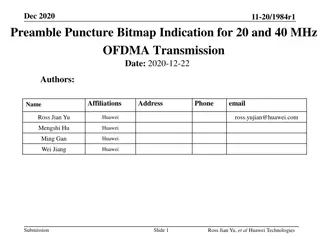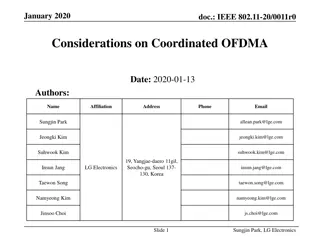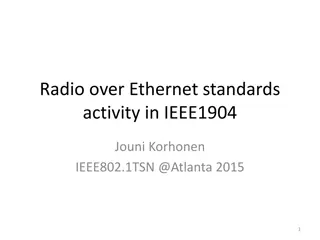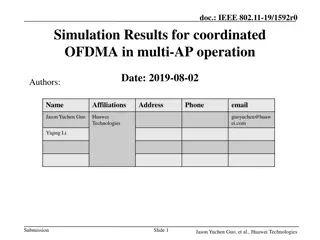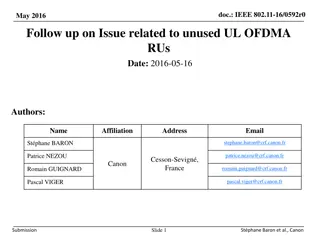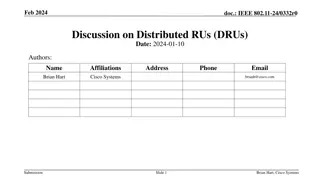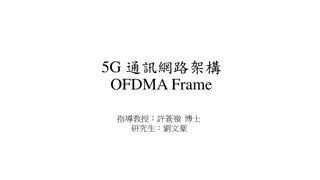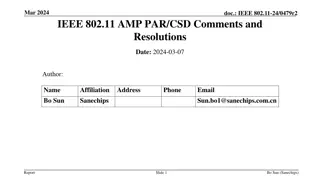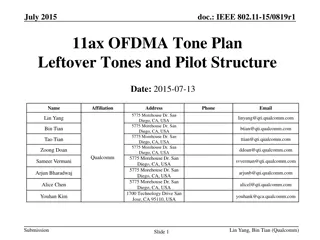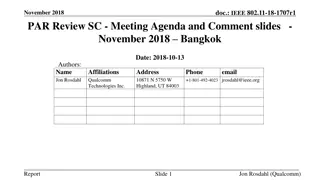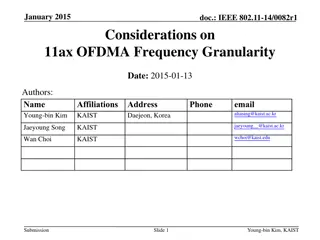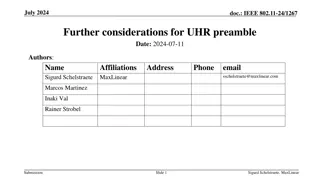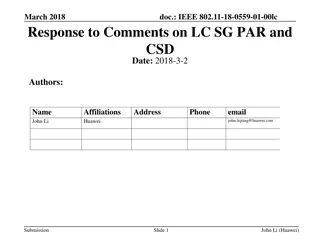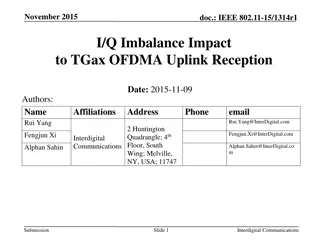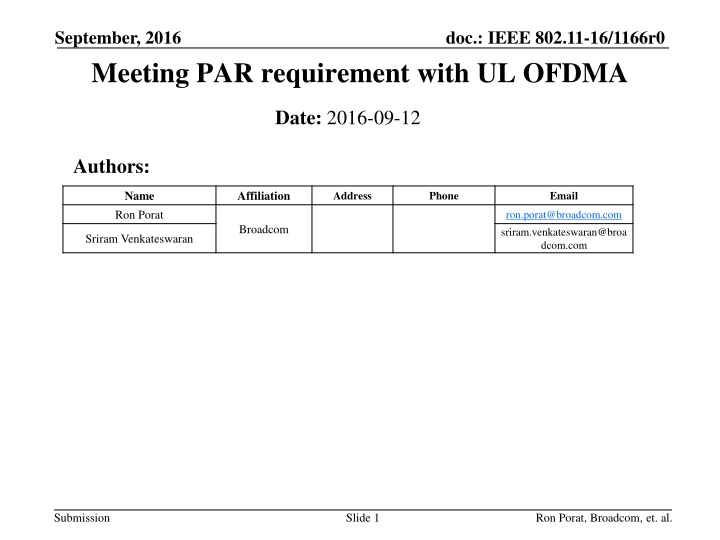
Understanding UL OFDMA in IEEE 802.11-16/1166r0 for Enhanced Throughput
Explore the potential of UL OFDMA in IEEE 802.11-16/1166r0 to improve throughput by scheduling multiple STAs simultaneously. Discover how UL OFDMA mitigates contention and collision issues, leading to gains in SNR and PHY rates. Delve into the efficiency of channel access with UL OFDMA and quantify gains in a simplified outdoor large BSS scenario.
Download Presentation

Please find below an Image/Link to download the presentation.
The content on the website is provided AS IS for your information and personal use only. It may not be sold, licensed, or shared on other websites without obtaining consent from the author. If you encounter any issues during the download, it is possible that the publisher has removed the file from their server.
You are allowed to download the files provided on this website for personal or commercial use, subject to the condition that they are used lawfully. All files are the property of their respective owners.
The content on the website is provided AS IS for your information and personal use only. It may not be sold, licensed, or shared on other websites without obtaining consent from the author.
E N D
Presentation Transcript
September, 2016 doc.: IEEE 802.11-16/1166r0 Meeting PAR requirement with UL OFDMA Date: 2016-09-12 Authors: Name Ron Porat Affiliation Address Phone Email ron.porat@broadcom.com sriram.venkateswaran@broa dcom.com Broadcom Sriram Venkateswaran Submission Slide 1 Ron Porat, Broadcom, et. al.
September, 2016 doc.: IEEE 802.11-16/1166r0 Outline UL OFDMA, introduced in 11ax, allows multiple STAs to send data to AP simultaneously Example use case: ACKs from multiple STAs scheduled UL OFDMA eliminates losses due to contention and collision Goal of this presentation: check if UL OFDMA can meet 4x throughput gain stated in the PAR in one scenario Gains over 11ac a. SNR gains, most useful for far-away users Users concentrate power in smaller RUs available in OFDMA Eg: 20 MHz BSS, STA has SNR 6 dB below required SNR for 20 MHz MCS 0 11ac impossible to communicate 11ax concentrate power in 26 tone RU 9.7 dB gain b. Better PHY rates for same SNR in outdoor channels 11ax has longer GI, larger FFT size to handle channels with longer delay spread Orthogonal to OFDMA c. Channel access is more efficient with UL OFDMA (avoids collisions) Focus here: quantify gains due to (a) & (b) in simplified version of outdoor large BSS scenario Submission Slide 2 Ron Porat, Broadcom, et. al.
September, 2016 doc.: IEEE 802.11-16/1166r0 Deployment geometry Simpler version of outdoor large BSS (#4 in Simulation Scenarios document) Single BSS, 80 MHz ICD = 130 m Hexagon side = 75 m Approximate by circle of radius 75 m STAs deployed uniformly at random inside circle AP Configuration & channel models AP: 4 antennas, STA: 1 antenna Transmit power at each STA: 15 dBm Channel Models: UMi-LoS and UMi-NLoS Radius = 75 m UMi-LoS or UMi-NLoS Single BSS, 80 MHz bandwidth Submission Slide 3 Ron Porat, Broadcom, et. al.
September, 2016 doc.: IEEE 802.11-16/1166r0 SNR statistics fc = 5.25 GHz, STA tx power = 15 dBm SNR before shadowing: X = loge d LoS, 20 MHz: = 68.6, = 9.55 NLoS, 20 MHz: = 69.58, = 15.95 PDF of X: ae-bx, x SNRmin SNRmin = loge(R0) b = 2/ a = (2/ R02) e2 / SNR after shadowing = Y = X + N(0, 2) 2 = 3 dB for LoS, 4 dB for NLoS PDF of Y = [a exp(b2 2/2)] ? ??Q(?????? ? Q(.) is the standard Gaussian Q-function Q(x) asymptotically exp(-x2/2) + ??) ? Submission Slide 4 Ron Porat, Broadcom, et. al.
September, 2016 doc.: IEEE 802.11-16/1166r0 SNR statistics over 20 MHz LoS NLoS Submission Slide 5 Ron Porat, Broadcom, et. al.
September, 2016 doc.: IEEE 802.11-16/1166r0 Simulation setup for UL OFDMA vs 11ac Scheme A: Baseline, 11ac STA chooses best rate among a. 80 MHz MCS 0-9 b. 40 MHz MCS 0 c. 20 MHz MCS 0 80 MHz Scheme B: OFDMA with 4 users Pick better sum throughput among 4 x 242 RU 1 x 484 RU + 2 x 242 RU + 1 x 26 RU User on 242 RU 6 dB gain, 484 RU 3 dB gain, 26 RU 15 dB gain User with higher SNR is allotted to larger RU. STA picks best MCS from 0 to 9 Scheme C: OFDMA with 16 users Best throughput among [x 106 RUs (16-2x) 52 RUs x 26 RUs], x = 0,1,2,3,4,5 User with higher SNR is allotted to larger RU. STA picks best MCS from 0 to 9 User on 106 RU 9 dB gain, 52 RU 12 dB gain, 26 RU 15 dB gain Submission Slide 6 Ron Porat, Broadcom, et. al.
September, 2016 doc.: IEEE 802.11-16/1166r0 Can the AP reach the user at cell edge in NLoS channels? STA must hear beacons and trigger frames from AP for UL OFDMA to work Noise power with 20 MHz bandwidth: SNR required for MCS 0: UMi-NLoS path loss at 75 m: Shadowing: Accounts for all but the worst 10% of shadowing losses 96 dBm 7.5 dB (slide 14, Nrx = 1) 110.2 dB 4 dB Q-1(0.1) = 5.2 dB Transmit power = Noise power + SNR required + Path Loss + Shadowing Loss = 96 + 7.5 + 110.2 + 5.2 dBm = 26.9 dBm Around typical transmit power of APs, so power budget sufficient with 20 MHz beacons/trigger frames Submission Slide 7 Ron Porat, Broadcom, et. al.
September, 2016 doc.: IEEE 802.11-16/1166r0 SNR to MCS mapping Larger GI, FFT size 11ax can support higher MCS at same SNR Target PER = 10% No SNR value for MCS floor > 10% PER 11ac baseline SNR for 40 MHz MCS 0 = SNR for 20 MHz MCS 0 + 3 dB SNR for 80 MHz MCS x = SNR for 20 MHz MCS x + 6 dB 11ax OFDMA SNR for 484 RU = SNR for 242 RU + 3 dB SNR for 106 RU = SNR for 242 RU 3.6 dB SNR for 52 RU = SNR for 242 RU 6.7 dB SNR for 26 RU = SNR for 242 RU 9.7 dB Reference: See appendix for figures Submission Slide 8 Ron Porat, Broadcom, et. al.
September, 2016 doc.: IEEE 802.11-16/1166r0 Throughput comparison UMi-LoS Mean (Mbps) 50 percentile (Mbps) 5 percentile (Mbps) 11ac 244.95 234 234 444.11 1.83x 444.44 1.89x 444.44 1.89x 4 user UL OFDMA (Sum throughput) UMi-NLoS Mean (Mbps) 50 percentile (Mbps) 5 percentile (Mbps) 11ac 29 13.5 0 120.01 4.14x 116.25 8.61x 40.62 Inf x 4 user UL OFDMA (Sum throughput) 174.92 6.03x 175.21 12.98x 136.67 Inf x 16 user UL OFDMA (Sum throughput) Submission Slide 9 Ron Porat, Broadcom, et. al.
September, 2016 doc.: IEEE 802.11-16/1166r0 Conclusions Checked whether UL OFDMA in 11ax can provide 4x gain over 11ac in one scenario Source of gains Higher SNR for far away users by transmitting on smaller RUs Better handling of long delay spread channels (orthogonal to OFDMA) Does not include channel access gains In LoS, gain ~ 1.83x with 4 user OFDMA In NLoS , gain ~ 8.6x with 4 user OFDMA, 13x with 16 user OFDMA at 50 percentile point Submission Slide 10 Ron Porat, Broadcom, et. al.
September, 2016 doc.: IEEE 802.11-16/1166r0 Appendix Submission Slide 11 Ron Porat, Broadcom, et. al.
September, 2016 doc.: IEEE 802.11-16/1166r0 UMi-LoS, MCS 0 to 4 11ax 11ac Submission Slide 12 Ron Porat, Broadcom, et. al.
September, 2016 doc.: IEEE 802.11-16/1166r0 UMi-LoS, MCS 5 to 9 11ax 11ac Submission Slide 13 Ron Porat, Broadcom, et. al.
September, 2016 doc.: IEEE 802.11-16/1166r0 UMi-NLoS, MCS 0 to 4 11ax 11ac Submission Slide 14 Ron Porat, Broadcom, et. al.
September, 2016 doc.: IEEE 802.11-16/1166r0 UMi-NLoS, MCS 5 to 9 11ax 11ac Submission Slide 15 Ron Porat, Broadcom, et. al.

